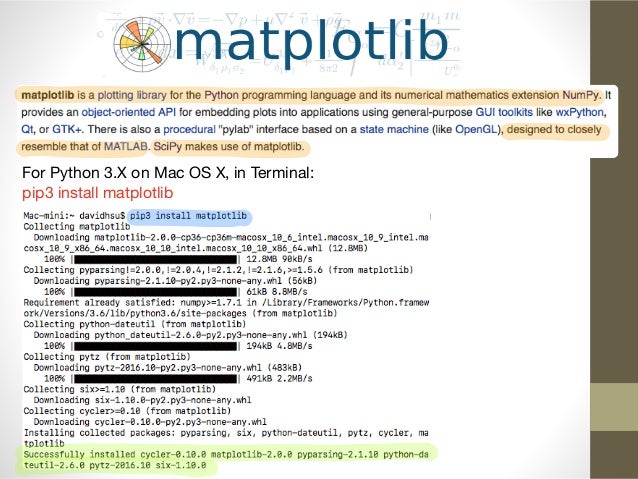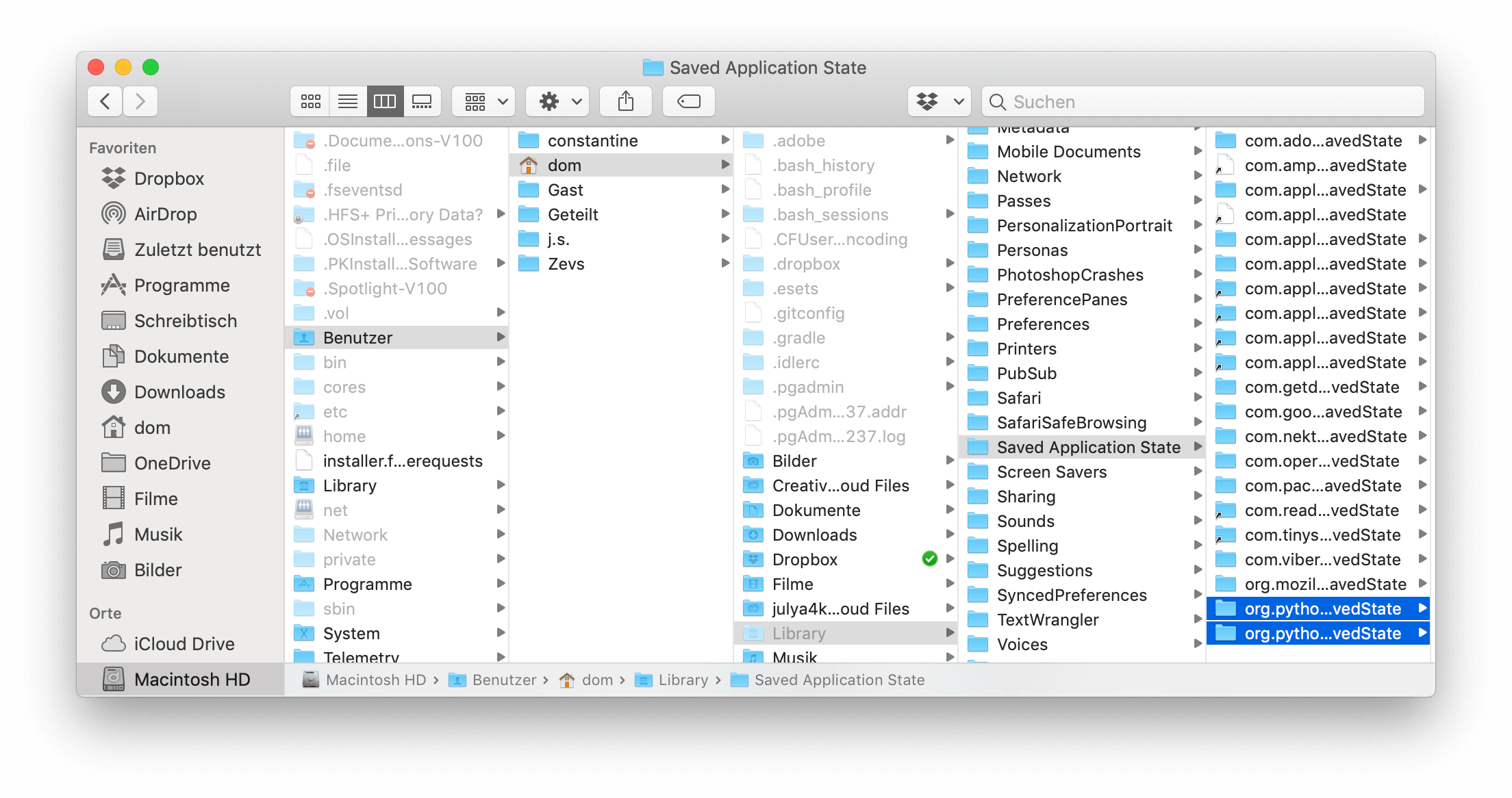Python Image Library Mac
I'm an extremely amateur programmer; I've done some recreational algorithmics programming, but I honestly have no idea how libraries and programming languages really fit together. I'm supposed to w. Oct 07, 2016 The Python Imaging Library or PIL allowed you to do image processing in Python. The original author, Fredrik Lundh, wrote one of my favorite Python blogs when I first started learning Python. However PIL’s last release was way back in 2009 and the blog also stopped getting updated. Fortunately, there were some other Python folks Continue reading An Intro to the Python Imaging Library. Python Imaging Library (abbreviated as PIL) (in newer versions known as Pillow) is a free library for the Python programming language that adds support for opening, manipulating, and saving many different image file formats. It is available for Windows, Mac OS X and Linux.
- Python Image Library Mac Download
- Python Image Library Machines
- Python Image Library Anaconda
- Python Image Library Download
- Python Image Module
Apr 02, 2020 Python Imaging Library (Fork) Pillow is the friendly PIL fork by Alex Clark and Contributors.PIL is the Python Imaging Library by Fredrik Lundh and Contributors. As of 2019, Pillow development is supported by Tidelift. This image library is not going to give you fancy high performance operations on images. It allows you to read in an image and manipulate its pixels. Then you can save the new image to a file, or you can display the image in a window. Thats really about it, but its really all you want to do if you are teaching an introductory computer science.
Bob Savage <bobsavage@mac.com>
Python on a Macintosh running Mac OS X is in principle very similar to Python onany other Unix platform, but there are a number of additional features such asthe IDE and the Package Manager that are worth pointing out.
4.1. Getting and Installing MacPython¶
Mac OS X 10.8 comes with Python 2.7 pre-installed by Apple. If you wish, youare invited to install the most recent version of Python 3 from the Pythonwebsite (https://www.python.org). A current “universal binary” build of Python,which runs natively on the Mac’s new Intel and legacy PPC CPU’s, is availablethere.
What you get after installing is a number of things:
A
Python3.8folder in yourApplicationsfolder. In hereyou find IDLE, the development environment that is a standard part of officialPython distributions; PythonLauncher, which handles double-clicking Pythonscripts from the Finder; and the “Build Applet” tool, which allows you topackage Python scripts as standalone applications on your system.A framework
/Library/Frameworks/Python.framework, which includes thePython executable and libraries. The installer adds this location to your shellpath. To uninstall MacPython, you can simply remove these three things. Asymlink to the Python executable is placed in /usr/local/bin/.
The Apple-provided build of Python is installed in/System/Library/Frameworks/Python.framework and /usr/bin/python,respectively. You should never modify or delete these, as they areApple-controlled and are used by Apple- or third-party software. Remember thatif you choose to install a newer Python version from python.org, you will havetwo different but functional Python installations on your computer, so it willbe important that your paths and usages are consistent with what you want to do.
IDLE includes a help menu that allows you to access Python documentation. If youare completely new to Python you should start reading the tutorial introductionin that document.
If you are familiar with Python on other Unix platforms you should read thesection on running Python scripts from the Unix shell.
4.1.1. How to run a Python script¶
Your best way to get started with Python on Mac OS X is through the IDLEintegrated development environment, see section The IDE and use the Help menuwhen the IDE is running.
If you want to run Python scripts from the Terminal window command line or fromthe Finder you first need an editor to create your script. Mac OS X comes with anumber of standard Unix command line editors, vim andemacs among them. If you want a more Mac-like editor,BBEdit or TextWrangler from Bare Bones Software (seehttp://www.barebones.com/products/bbedit/index.html) are good choices, as isTextMate (see https://macromates.com/). Other editors includeGvim (http://macvim-dev.github.io/macvim/) and Aquamacs(http://aquamacs.org/).
To run your script from the Terminal window you must make sure that/usr/local/bin is in your shell search path.
To run your script from the Finder you have two options:
Drag it to PythonLauncher
Select PythonLauncher as the default application to open yourscript (or any .py script) through the finder Info window and double-click it.PythonLauncher has various preferences to control how your script islaunched. Option-dragging allows you to change these for one invocation, or useits Preferences menu to change things globally.
4.1.2. Running scripts with a GUI¶
With older versions of Python, there is one Mac OS X quirk that you need to beaware of: programs that talk to the Aqua window manager (in other words,anything that has a GUI) need to be run in a special way. Use pythonwinstead of python to start such scripts.
With Python 3.8, you can use either python or pythonw.

4.1.3. Configuration¶
Python on OS X honors all standard Unix environment variables such asPYTHONPATH, but setting these variables for programs started from theFinder is non-standard as the Finder does not read your .profile or.cshrc at startup. You need to create a file~/.MacOSX/environment.plist. See Apple’s Technical Document QA1067 fordetails.
For more information on installation Python packages in MacPython, see sectionInstalling Additional Python Packages.
4.2. The IDE¶
MacPython ships with the standard IDLE development environment. A goodintroduction to using IDLE can be found athttp://www.hashcollision.org/hkn/python/idle_intro/index.html.
4.3. Installing Additional Python Packages¶
There are several methods to install additional Python packages:
 But if you still use iPhoto, then you can move photos, videos or folder from Google Drive to iPhoto on Mac. To learn how to move photos and videos from Google Drive to iPhoto on Mac, check out the steps given below. Select 'Import to Library.' A 'Finder Window' opens up. In this guide we’ll be tackling the challenge of moving your whole photo library from one. Download Originals to Mac is selected. On iOS, if you have. MacOS client for Google Drive. How to safely move your Mac's iPhoto library onto an external drive. By Stephen Robles Saturday, January 24, 2015, 11:00 pm PT (02:00 am ET) Today's digital cameras and advanced smartphones like. In this tutorial I’ll show you how to copy your iPhoto library to your dropbox or google drive account so that you can keep your images safe in the cloud. The first thing you’re going to need to do is make sure you have a dropbox or google drive account that can cope with your library. Nov 12, 2019 This happens when you back up your Photos or iPhoto Library and then, before the next backup, delete a few images. The next time the backup runs, you want to be confident that the images you deleted from the library aren't also removed from the existing backup.
But if you still use iPhoto, then you can move photos, videos or folder from Google Drive to iPhoto on Mac. To learn how to move photos and videos from Google Drive to iPhoto on Mac, check out the steps given below. Select 'Import to Library.' A 'Finder Window' opens up. In this guide we’ll be tackling the challenge of moving your whole photo library from one. Download Originals to Mac is selected. On iOS, if you have. MacOS client for Google Drive. How to safely move your Mac's iPhoto library onto an external drive. By Stephen Robles Saturday, January 24, 2015, 11:00 pm PT (02:00 am ET) Today's digital cameras and advanced smartphones like. In this tutorial I’ll show you how to copy your iPhoto library to your dropbox or google drive account so that you can keep your images safe in the cloud. The first thing you’re going to need to do is make sure you have a dropbox or google drive account that can cope with your library. Nov 12, 2019 This happens when you back up your Photos or iPhoto Library and then, before the next backup, delete a few images. The next time the backup runs, you want to be confident that the images you deleted from the library aren't also removed from the existing backup.
Packages can be installed via the standard Python distutils mode (
pythonsetup.pyinstall).Many packages can also be installed via the setuptools extensionor pip wrapper, see https://pip.pypa.io/.
4.4. GUI Programming on the Mac¶

There are several options for building GUI applications on the Mac with Python.
PyObjC is a Python binding to Apple’s Objective-C/Cocoa framework, which isthe foundation of most modern Mac development. Information on PyObjC isavailable from https://pypi.org/project/pyobjc/.
The standard Python GUI toolkit is tkinter, based on the cross-platformTk toolkit (https://www.tcl.tk). An Aqua-native version of Tk is bundled with OSX by Apple, and the latest version can be downloaded and installed fromhttps://www.activestate.com; it can also be built from source.
wxPython is another popular cross-platform GUI toolkit that runs natively onMac OS X. Packages and documentation are available from https://www.wxpython.org.
Python Image Library Mac Download
PyQt is another popular cross-platform GUI toolkit that runs natively on MacOS X. More information can be found athttps://riverbankcomputing.com/software/pyqt/intro.
Python Image Library Machines
4.5. Distributing Python Applications on the Mac¶
The “Build Applet” tool that is placed in the MacPython 3.6 folder is fine forpackaging small Python scripts on your own machine to run as a standard Macapplication. This tool, however, is not robust enough to distribute Pythonapplications to other users.
The standard tool for deploying standalone Python applications on the Mac ispy2app. More information on installing and using py2app can be foundat http://undefined.org/python/#py2app.
Python Image Library Anaconda
4.6. Other Resources¶
Python Image Library Download
The MacPython mailing list is an excellent support resource for Python users anddevelopers on the Mac:
Python Image Module
Another useful resource is the MacPython wiki: